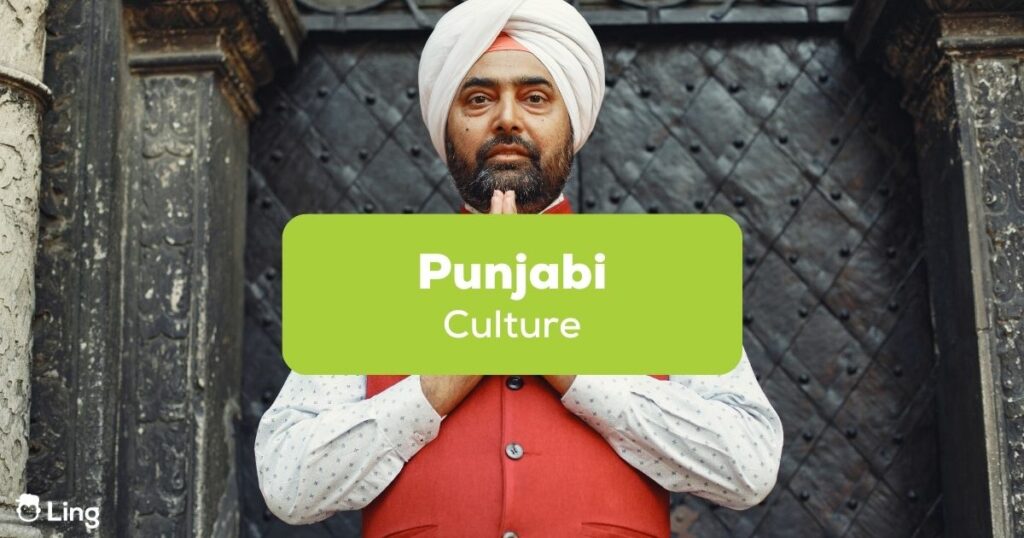Punjabi culture is one of the most prolific & prominent cultures from the Indian subcontinent to become popular across the modern world. This doesn’t mean that other cultures from this vast region are any less. It’s just that, thanks to the inherent boisterous nature of the Punjabis and the fact that they were the earliest immigrants to the West, the Punjabi culture and traditions found an easy space to create an impact on the world and how!
Globally addressed as the desi culture, this vast umbrella term includes various cultures from India, Pakistan, Bangladesh, Nepal, Bhutan, Sri Lanka, and the Maldives. But ask any person outside of this region what does desi mean and they are sure to describe food, traditions, music and dance, and practices of the Punjabi people!
The Punjabi culture comes with various ideologies related to the Punjabi language, dances, literature, wedding traditions, folk music, and so much more! So if you want to know about all this, then keep reading!
Page Contents
Punjabi Culture
From ancient to the present, the Punjabi cultural legacy is among the richest in human history. At the very least, we can say that this culture’s extent, depth, and richness are incredible. Ideology, food, theology, art, language, songs, traditions, archaeology, heritage, and ethics are some critical areas that have somehow molded the Punjabi culture.
If you want to experience the culture, one quick way to do that is by going to the cities. The Sikh community in India places higher importance on Punjabi in several towns. Guru Nanak was born in the Nankana Sahib area of Punjab, so Sikhs from around the globe visit the place. The most notable attractions in Punjab, Pakistan, are the Tomb of Jahangir and the Badshahi Mosque in Lahore. Data Sahib is another renowned site in the Punjab State, and most people visit this Darbar annually.
Similarly, in the Indian state of Punjab, Amritsar (the city of amrit or nectar) is the most revered spot for Sikhs and Punjabi Hindus due to the presence of the Sikh temple or Gurudwara – Sri Harmandir Sahib (. This sacred Sikh holy temple is popularly known as Sri Darbar Sahib or the Golden Temple, due to its scenic beauty and golden coating. And every year on Guru Nanak Jayanti, it feeds langar to more than a 100,000 people in its free community kitchen!
Isn’t all that amazing to know? So, let’s learn more about the Punjabi culture in the sections below.
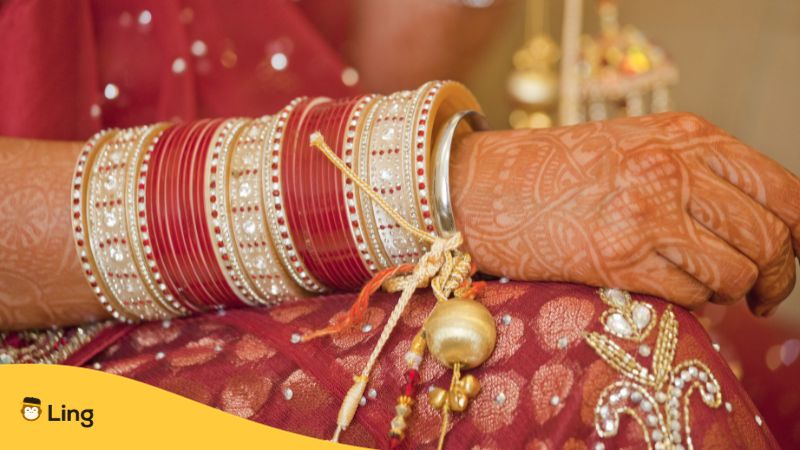
Punjabi Wedding
Punjabi have an actual religious wedding ceremony, and the roka is the first step in the pre-wedding customs of the Punjabi Hindu bride and groom. A few days before the wedding, Mehendi or Henna artists are hired to paint elaborate patterns on the hands of the bride and groom and all the female members of their family and friends.
The musical event, known as Sangeet or Jaago is often held on the same evening as the engagement ceremony, wherein females of the family sing and dance Giddha on traditional wedding Punjabi folk songs. The bride and groom visit the local temple, take a holy bath, and then prepare for the auspicious marriage rituals.
Traditionally, the groom arrives to the wedding venue mounted on a mare alongside a Baraat or Jhaanjh (a wedding procession where groom’s side arrives dancing to the beats of Punjabi dhols and brass bands). Thereafter, Varmala, or garland exchange takes place between the bride and the groom. This is followed by the Saat Phere (seven rounds) around the auspicious fire with the couple taking nuptial vows with each round.
A Sikh wedding or Ananda Karaj (translates to ceremony of joy), mostly takes place within a Gurudwara or Sikh temple. The couple takes Laava Phere or four circumambulations around the Sikh holy book – Guru Granth Sahib – to get married. The pre-wedding and post-wedding rituals remain the same though.
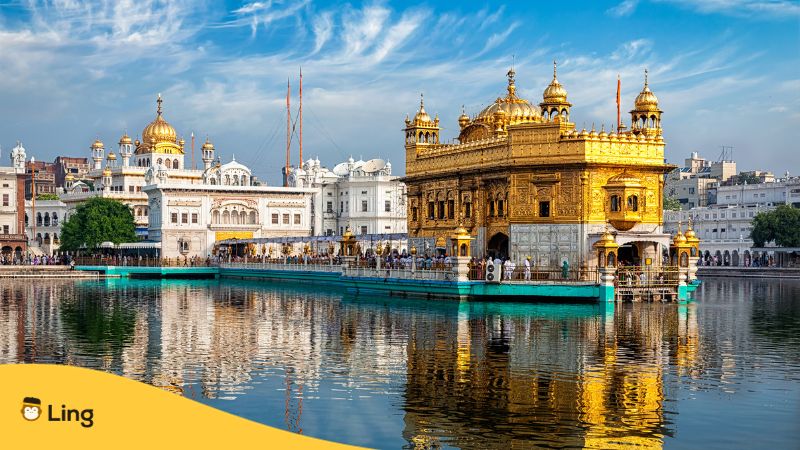
Punjabi Religion
In Punjab, people practice many different religions. But Sikhs and Hindus make up most of the people of Punjab, India, and Khatris are the most common Hindu ethnic group. However, Brahmin, Rajput, and Baniya are all also there.
Due to Sikhism’s historical roots, the state has a large Sikh population. Punjab is home to several Sikh religious institutions, not to mention the world-famous Golden Temple in Amritsar, which draws large crowds from all over the globe. In Indian Punjab, Muslims, Christians, and Jains are also among the Punjabi population.
Punjabi Literature
The majority of the works of Sikh Gurus may be found in Punjabi literature, along with some poetry. One of the earliest pieces of literature that have ever been discovered is Guru Nanak’s writings, popularly known as the Janamsakhis. Punjabi language is written in the Gurmukhi script.
There are also specific yogic ideas like those of Gorakshanath and Charpatnah that may be found. But poetry, Sufi music, and ghazals marked the beginning of the main body of literature. Punjabi literature manifests and depicts the types of people that Punjabis are. The people of Punjab are free-spirited, kind and liberal. They enjoy every occasion and celebration to the fullest. They have a rich history and culture and are bright and dynamic.
Some well-known tales include Sohni Mahiwal by Fazal Shah, Heer Ranjha by Waris Shah, and Mirza Sahiba by Hafiz Barkhudar. Bhai Vir Singh, Dhani Ram Chatrik, Mohan Singh, Shiv Kumar Batalvi, and Puran Singh Kalra ‘Gulzar’ are some contemporary Punjabi authors.
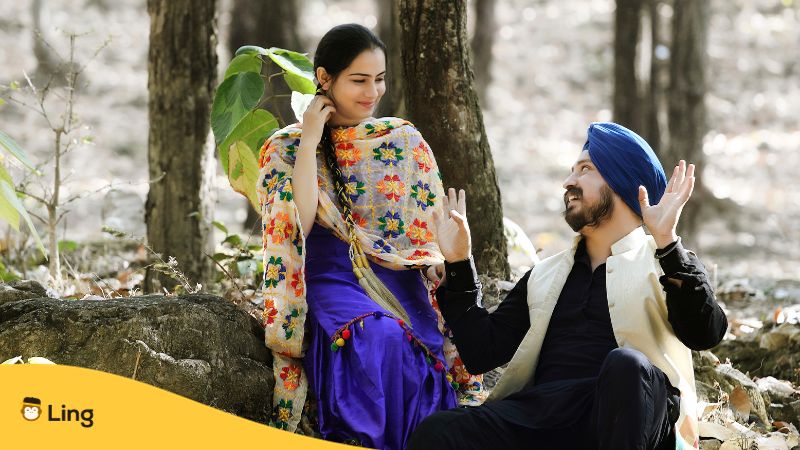
Punjabi Clothes
For comfort, women like to wear Punjabi outfits. The salwar kameez is a well-known Punjabi dress well across most of India. It is a combination of a Kurta (long tunic) and a salwar with a straight cut. Patiala salwar is a loose, pleated trouser originally worn by males before becoming popular among women.
Below are some other types of clothes that you must know of.
Punjabi Ghagra
Punjabi ghagra is part of a four-piece ensemble originally from Punjab but also worn throughout Haryana and regions of Himachal Pradesh. This clothing is often used during the Punjabi folk dance known as Giddha, in which ladies spin around in hypnotic colors while singing traditional melodies.
Kurti Styles
The traditional Kurta/kurti, a garment worn in Northern India, was once a short-sleeved shirt. Kurtas come in various styles, including multani, phulkari, bandhani, and muktasari. Phulkari, which translates to “flower craft,” has been ingrained in Punjabi culture since the 15th century.
Ladies wear it at weddings and other formal events. The ladies of traditional Punjab wear it on shawls, Kurtas, Dupattas, and Lehengas with eye-catching combinations of exquisite designs on all occasions.
Turban
Turban is an everyday attire for Sikh men, and come in various attractive styles. The headgear/turban that Punjabi Sikh men wear is Paga. This turban allows them to neatly arrange their long hair.
Punjabi Jama
Jama refers to the traditional clothing worn by males during the Mughal era. The majority of churidar pajamas are blue and made of Sussi (cotton). However, individual preferences may help you choose other colors.

Punjabi Art
Different types of art and craft have been practiced in Punjab for a very long time. Punjabi people desire to preserve their traditions, so they choose to have traditional decorations rather than more modern or western ones. The toy business is well-known for its use of wood and has grown to be an essential handicraft sector globally.
Painting mud walls is an everyday activity among rural women in Punjab, and the key to producing wonders is a feminine touch. For instance, aesthetically appealing furniture called mooraas or beautiful stools or low chairs can be seen in practically every house.
Flat-woven carpets, hardwood furniture, and lacquer ware items are standard in Punjabi homes. The handicraft sector has emerged as the preferred choice among ex-pats looking to buy presents for loved ones. Even the khussas – a type of footwear, have patterns depicting Punjabi art, as you can see in the picture above.
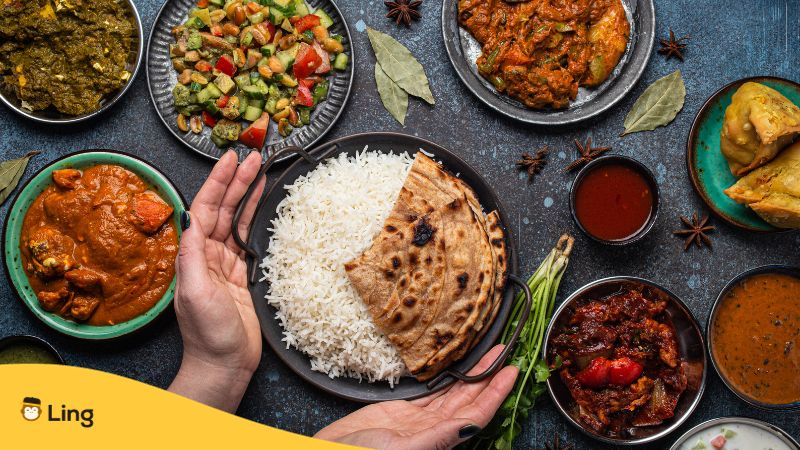
Punjabi Food
Punjabi cuisine has a long legacy of unique cooking techniques. One of Punjab’s most distinctive and well-liked types of cuisine is tandoori, which is also well-liked in Hong Kong, Canada, India, and the UK.
The ancient Harappan civilization adopted the most popular Punjabi dishes, inspired by farming and agriculture. The meals, such as Sarson da saag and Makki di roti are well-liked because of their luscious buttery tastes with meat and vegetable dishes. Another famous native-like type is basmati rice, grown in large quantities here.
Punjab is the primary grower of wheat. Hence, wheat is used in most of their top dishes. Additionally, several condiments and culinary additives flavor and color their dishes. Particularly in desserts and many other foods, natural food coloring is used.
Within various Punjabi locations, they prepare multiple foods in different methods. They adore eating beef, chicken, or lamb. One of the most well-known recipes is tandoori chicken. Many spices include cumin, carom seeds, coriander powder, and garam masala.
Punjabi Cooking Tools
Punjab has its traditional culinary style, much like every other region. In addition to gas cookers, they also use brick and wood-fired ovens to prepare their food. This tandoori technique was adapted from Punjab in India, while the tandoori style requires a Tandoor or a clay oven.
Punjabis like eating food prepared in a tandoor. After the 1947 partition of India, when a huge lot of Punjabis relocated to Delhi, this fashion generally became famous throughout India. The tandoor is known as Kath tandoors in rural Punjab.
Machchli Amritsari
Machchli/macchi Amritsari is a delight for all fish lovers. Beautiful fish chunks have been deep-fried to golden perfection in a peppery batter.
Haleem
Haleem is also served with meat inside of it. It is a blend of several legumes and foods high in protein, including spices. It takes an entire day to cook and isn’t ready until the next day. You just need to keep mixing.
Paneer Tikka
Paneer Tikka is made of marinated paneer (cottage cheese) cubes covered in a mixture of masalas (spices) and grilled on skewers.
Punjabi Kadhi Pakodi
Punjabi Kadhi Pakodi is a delectable creamy sauce in which soft fried pakodis are dipped. Another delicacy is karahi, a yellow-colored sauce often served with rice, roti, or naan, and little cake-shaped pakoras prepared with gram flour called besan that are dipped in it.
Shalgam Gobhi Gajar
It is an old-fashioned pickle from India, prepared with turnips, cauliflower, and carrot. It is sour, peppery, and sweet and is often made during the winter and served with Punjab’s buttery cuisine. It is a side dish like pickle/kimchi and is called achaar.
Bhatti Da Murg Pindiwala
The best Punjabi food is served by Bhatti da Murg Pindiwala, a street vendor from Punjab. Rich Indian spices, a tomato-based sauce, and fragrant lotus stem stock are used to create the chicken curry.

Punjabi Dance
Music is the general and musical component of the festivity that Punjabis are renowned for. Folk dances and music are pretty popular nationwide, not only in Punjab. There are several dance forms. Among them is the Bhangra, which has also gained enormous popularity in the West. This dancing style started many decades ago when Punjabi villagers gathered to celebrate the beginning of the harvests.
Giddha, Luddhi, Dhamal, and Sammi are other well-known dances in the area. Bollywood has also seen a rise in the popularity of Punjabi music.
Wrapping Up
That’s it for this blog post. Learning Punjabi can be a lot of fun if done correctly and with the help of the right resources. That’s precisely why I would like to introduce you to the Ling app, which can help you ace any language, especially the Punjabi language, with the help of native speakers who guide you at every step.
We provide you with a myriad of ways of learning this beautiful language. Punjabi is also the official language of Punjab. It makes it essential to understand as many Punjabis have migrated to the UK, US, and especially Canada, so you will often come across them.
So, download the app from Google Playstore or App Store and start learning Punjabi!
Updated by Punya
